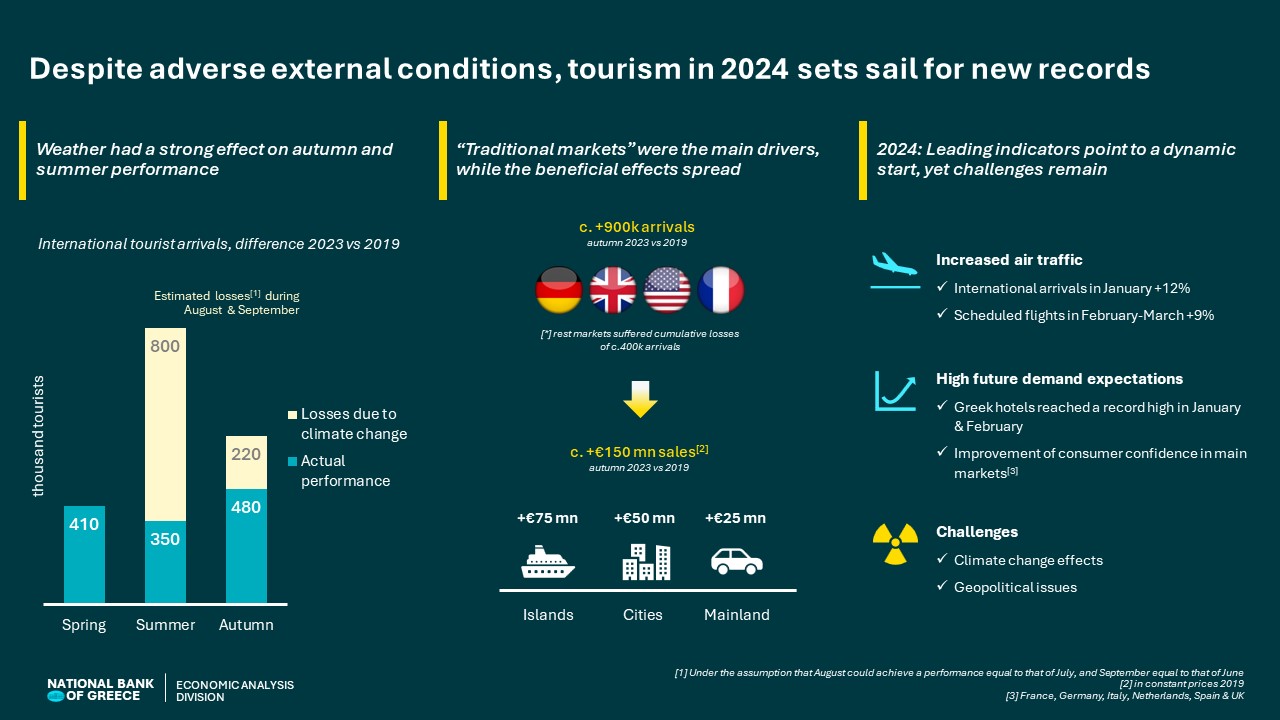Greece welcomed 9.3 million foreign tourists in autumn 2023, marking a 6% increase compared to 2019. The extended warmth experienced during the October-November period, which surged by 13%, helped counterbalance the effects of the extreme weather events in September, which saw only a 1% increase.
The notable performance during autumn was primarily fueled by the "traditional markets" such as Germany, the UK, USA, and France, collectively increasing their share in Greece's foreign arrivals by 8 percentage points from 2019 to 2023, reaching 43% from 35%. Specifically, Germany and the UK contributed an additional 800,000 tourists compared to 2019, maintaining their positions as the leading markets, while the US elevated to the 3rd position with 70,000 more tourists. Furthermore, this trend aligns with the robust performance of air arrivals, which, with a 22% surge compared to 2019, and constituting two-thirds of all arrivals, compensated for the still sluggish performance of road arrivals, which decreased by 25% compared to 2019. Additionally, this gradual shift in the tourist composition is advantageous in terms of revenue per tourist, showing a 3% increase in deflated receipts per overnight stay.
Against this background, hotel sales significantly increased in autumn, showing a 7% annual increase in deflated terms. Specifically, all major destination categories experienced growth: islands saw a 6% increase, urban centers saw an 8% rise, and mainland destinations surged by 14%, surpassing their pre-pandemic levels for the first time. However, it's important to acknowledge exceptions, as certain destinations faced declines, either due to relatively weaker demand (such as Mykonos and Santorini, down by 9%) or due to exceptional circumstances (like Thessaly, which experienced a 2% decrease).
Despite the overall positive trajectory observed during autumn, the impact of weather phenomena did not leave the sector unscathed, as:
- It hindered significant improvement in terms of seasonality, with autumn merely increasing its share in the past 12-month period by a marginal 0.1 percentage point compared to 2019.
- Greece experienced a decline in market share of approximately 0.5 percentage points within the Mediterranean market, dropping to 16.4% from 16.9% in 2019. This shift was propelled by Italy and Portugal, which demonstrated greater dynamism in the market.
Turning to the overall performance of the previous year, 2023 stands out as a milestone year for Greek tourism. Notably, December witnessed double-digit growth in arrivals, consistent with the trend observed in October and November. Moreover, tourist receipts surpassed €20 billion in 2023, aligning with our initial estimates made at the onset of the summer season.
Given this perspective, the focus now shifts to whether 2024 can surpass the remarkable performance of the previous year. Initial indications suggest a promising start to the year, particularly concerning air arrivals, which show a trend of double-digit annual growth during the first quarter. Furthermore, there are signs of larger aircraft connecting distant, high-spending destinations. This optimistic outlook is echoed in the heightened demand expectations among Greek hoteliers, with the respective index reaching its historically highest point in the January-February period, a development not witnessed in the broader Mediterranean market.
Therefore, amid a context of weak European growth (mainly in Germany) and geopolitical pressures, Greek tourism appears to be holding its ground, reclaiming its autonomous dynamism. Despite these challenges, Greece is poised to set new benchmarks in a year anticipated to witness a robust surge in international tourism. Nonetheless, caution is warranted, as geopolitical and climatic factors continue to exert influence, capable of unexpectedly and substantially impacting the trajectory of the sector.
Furthermore, the focus on Greek tourism has broadened, with efforts aimed not only at bolstering tourist arrivals but also at fostering sustainability, quality, and ensuring a balanced distribution of tourism activity across space and time. Encouragingly, both the tourism sector and supporting institutions demonstrate a heightened awareness and coordinated efforts toward achieving these objectives.
See the infographic:
